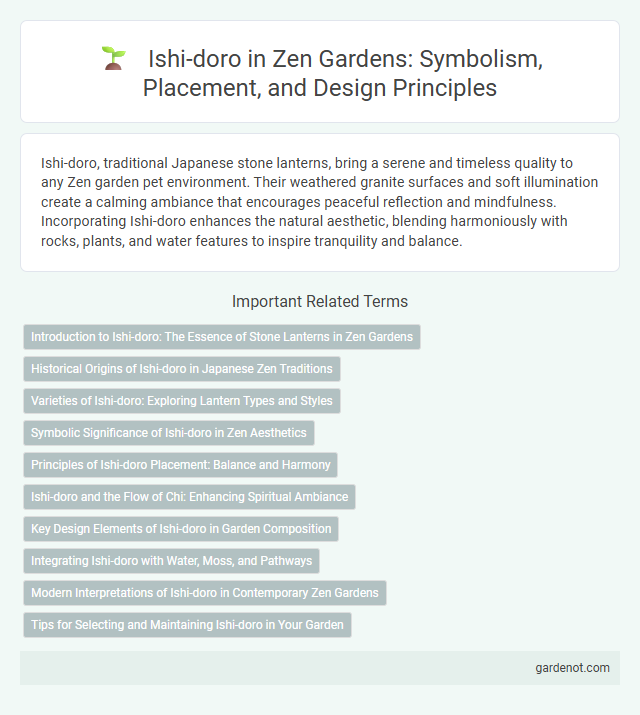Ishi-doro, traditional Japanese stone lanterns, bring a serene and timeless quality to any Zen garden pet environment. Their weathered granite surfaces and soft illumination create a calming ambiance that encourages peaceful reflection and mindfulness. Incorporating Ishi-doro enhances the natural aesthetic, blending harmoniously with rocks, plants, and water features to inspire tranquility and balance.
Introduction to Ishi-doro: The Essence of Stone Lanterns in Zen Gardens
Ishi-doro are traditional Japanese stone lanterns that symbolize tranquility and illumination within Zen gardens, embodying centuries of cultural heritage. Crafted from natural materials, these lanterns enhance the garden's spiritual ambiance by harmonizing light and shadow, guiding meditation and reflection. Their strategic placement reflects Zen principles of balance and simplicity, making Ishi-doro essential elements in creating serene, contemplative spaces.
Historical Origins of Ishi-doro in Japanese Zen Traditions
Ishi-doro, traditional stone lanterns, have deep roots in Japanese Zen traditions, originating during the Heian period (794-1185) when they were introduced from China as part of Buddhist temple architecture. These lanterns symbolized the illumination of the path to enlightenment and were strategically placed along garden pathways and temple grounds to guide monks during nighttime meditation. Over centuries, Ishi-doro evolved in design and spiritual significance, becoming integral to the aesthetic and meditative experience of Zen gardens.
Varieties of Ishi-doro: Exploring Lantern Types and Styles
Ishi-doro lanterns in Zen gardens showcase diverse varieties, including Yukimi-doro with broad umbrella-like roofs, Tachi-doro standing tall on a pedestal, and Oribe-doro featuring multi-tiered designs often adorned with intricate carvings. Each type serves a symbolic and aesthetic purpose, enhancing the garden's tranquil ambiance while reflecting traditional Japanese craftsmanship. Materials range from granite to bronze, influencing the lantern's texture and weathering qualities within the serene landscape.
Symbolic Significance of Ishi-doro in Zen Aesthetics
Ishi-doro, traditional Japanese stone lanterns, embody the symbolic essence of light and enlightenment in Zen aesthetics, representing the illumination of the path toward spiritual awakening. Their weathered surfaces and asymmetrical forms reflect wabi-sabi principles, emphasizing impermanence and natural beauty within the Zen garden. Positioned strategically near pathways or water features, Ishi-doro guide contemplation and evoke a serene atmosphere conducive to meditation.
Principles of Ishi-doro Placement: Balance and Harmony
Ishi-doro lanterns in Zen gardens embody the principles of balance and harmony by carefully integrating natural elements like stone, water, and plants to create a serene atmosphere. Their placement follows traditional guidelines emphasizing asymmetry and proportion, ensuring each lantern complements surrounding features without overwhelming the space. This thoughtful arrangement fosters a meditative ambiance, reflecting the Zen ideal of unity between human-made structures and the natural environment.
Ishi-doro and the Flow of Chi: Enhancing Spiritual Ambiance
Ishi-doro, traditional Japanese stone lanterns, play a crucial role in the flow of chi within Zen gardens, guiding energy and light through carefully aligned pathways. Their presence enhances the spiritual ambiance by symbolizing enlightenment and serenity, fostering a tranquil environment conducive to meditation and mindfulness. Strategically placed ishi-doro balance natural elements, harmonizing earth, water, and fire to promote positive energy circulation throughout the garden.
Key Design Elements of Ishi-doro in Garden Composition
Ishi-doro, traditional Japanese stone lanterns, serve as essential focal points in Zen garden composition, embodying harmony and tranquility. Their tiered structures, often featuring a base, light chamber, and ornate roof, balance natural materials with geometric precision, enhancing the garden's visual rhythm. Positioned strategically near pathways or water elements, Ishi-doro integrate light and shadow, guiding contemplative movement and fostering a serene atmosphere.
Integrating Ishi-doro with Water, Moss, and Pathways
Integrating Ishi-doro lanterns with water features, moss, and pathways creates a harmonious Zen garden ambiance that enhances tranquility and natural beauty. Positioning stone lanterns near reflective water surfaces emphasizes their sculptural form while moss around the base softens their presence and connects them to the earth. Carefully arranged pathways guide visitors through this serene landscape, creating contemplative spaces framed by Ishi-doro and lush greenery for an immersive meditative experience.
Modern Interpretations of Ishi-doro in Contemporary Zen Gardens
Modern interpretations of Ishi-doro in contemporary Zen gardens blend traditional aesthetics with minimalist design, utilizing sleek materials like stainless steel and glass to complement natural elements. These modern lanterns often incorporate LED lighting, offering energy-efficient illumination that enhances tranquility during nighttime. The fusion of ancient symbolism with innovative technology creates a harmonious balance between heritage and modernity in Zen garden landscapes.
Tips for Selecting and Maintaining Ishi-doro in Your Garden
Choose Ishi-doro lanterns made from durable stone such as granite or tuff to withstand outdoor weather conditions and maintain their aesthetic appeal. Position your Ishi-doro near pathways or water features to enhance garden ambiance while ensuring stability by placing them on level ground or a solid base. Clean the lanterns regularly with a soft brush and mild water solution to prevent moss buildup, preserving their texture and traditional appearance.
Ishi-dōro Infographic

 gardenot.com
gardenot.com